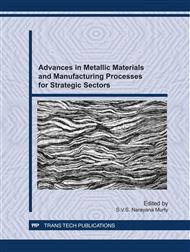p.638
p.644
p.650
p.656
p.665
p.671
p.677
p.683
p.689
Aging and Electrochemical Behaviour of 7017 Al-Zn-Mg Alloy of Various Tempers
Abstract:
Artificial aging behaviour of a 7017 Al-Zn-Mg alloy was studied by hardness measurement. The electrochemical behaviour of various alloy tempers, such as under-, peak-, and over-aged, have been evaluated by measuring variation of open circuit potential (OCP) with time and potentiodynamic polarization study in different environments. All the alloy tempers were tested in 3.5 wt. % NaCl solution at neutral (pH 7), at acidic (pH 1) and at alkaline (pH 12) conditions. It has been observed that the OCP values of the alloy tempers shifted toward noble direction with the increase of aging time in 3.5 wt. % NaCl solution. The polarization curves are more or less similar in shape exhibiting only active region in neutral (pH 7) and in acidic (pH 1) conditions, but an active-passive region at alkaline (pH 12) condition. The electrochemical parameters; Ecorr, Icorr, passive potential range (Ep) and passive current (ip), obtained from potentiodyanamic polarization curves for the alloy tempers in acid, neutral and alkaline solution; depend on the alloy tempers and the pH of the solution as well. Attempts have been made to explain the observed electrochemical behaviour of the alloy tempers, which is influenced by the microstructure, presence and distribution of second phase precipitates, accessed by DSC and XRD techniques.
Info:
Periodical:
Pages:
665-670
Citation:
Online since:
January 2012
Authors:
Keywords:
Price:
Сopyright:
© 2012 Trans Tech Publications Ltd. All Rights Reserved
Share:
Citation:


